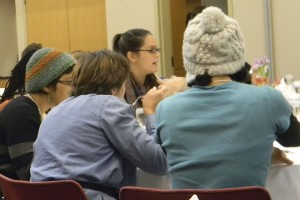Community spokesperson: We need to get young folks to stay in this community. Can you help with that?
Me: Can you say a little more about what you are looking for?
Community spokesperson: All of our kids are leaving. They graduate high school but there are no jobs for them. Sometimes they go off to college and we’d like them to come back home but without any jobs to offer…well, it’s just hard…
Me: How active are the young people in your community while they are in school?
Community spokesperson: Well we financed a new playing field at the school. There’s sports and after-school activities…You know, there are always a few that just want to hang around downtown and cause trouble…
Me: Are there leadership opportunities for young people in the community?
Community spokesperson: We’ve tried…kids don’t care about that stuff…they don’t have time…
And I’m sure you can fill in the rest of the conversation.
While most commu nity groups say they would like more participation from young people, there is little outreach done to really attract young people, put them into leadership positions and grant them the authority to make decisions. Another barrier is, for the most part, a lot of what happens under the heading of “Community Development” can sound really boring–meetings, planning, surveys–typically not activities that young adults are drawn to participate in. Yet, for a community to be sustainable it is important that the community leaders represent the citizens of the community. So here are some Do’s and Don’ts that can result in attracting more young people to community leadership.
nity groups say they would like more participation from young people, there is little outreach done to really attract young people, put them into leadership positions and grant them the authority to make decisions. Another barrier is, for the most part, a lot of what happens under the heading of “Community Development” can sound really boring–meetings, planning, surveys–typically not activities that young adults are drawn to participate in. Yet, for a community to be sustainable it is important that the community leaders represent the citizens of the community. So here are some Do’s and Don’ts that can result in attracting more young people to community leadership.
Behaviors to cultivate for increasing youth participation
- Adults need to be willing to share their power and responsibility
- Advertise the importance of young people consistently throughout the community
- Treat young people as individuals
- Strive for a critical mass rather than a single token youth
- Identify the skills that need to be developed for healthy youth-adult partnerships
- When you don’t know something, ask!
- Reward and celebrate the contributions made by young people
- Identify participation opportunities that are flexible and involve issues of concern to young people
- Make opportunities to participate action-oriented.
Behaviors to avoid
- Don’t isolate young people into subcommittees
- Don’t expect a single young person to represent the full spectrum of the youth perspective
- Be careful to listen respectfully and avoid interruptions
- Avoid parenting behavior
- Don’t avoid honest criticism — youth need to learn how to respond and they are tougher than you think
- Avoid insincere praise
None of these tips are guaranteed to increase youth participation but they are worth putting into practice. Reaching out to build fruitful adult-youth partnerships will pay dividends for any community willing to do a little extra work. To learn more about how to build these partnerships we recommend Building Community: A Toolkit for Youth and Adults in Charting Assets and Creating Change.
Tags: Youth


